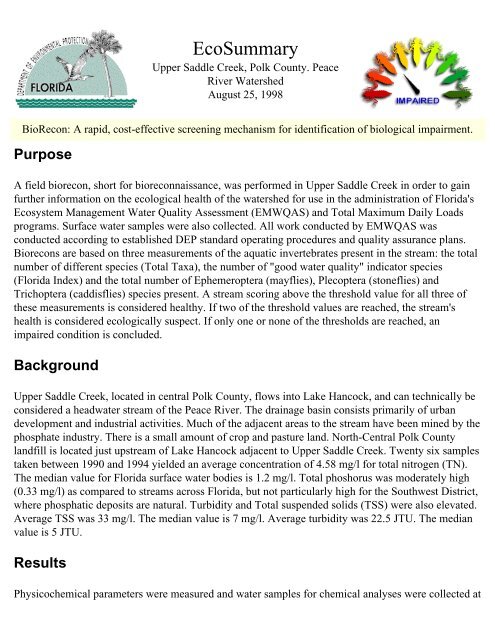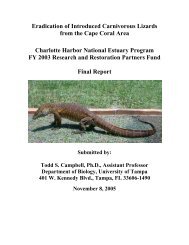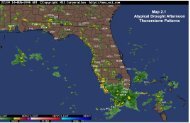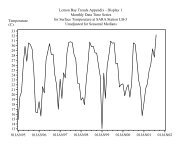Upper Saddle Creek, Polk County. Peace River Watershed
Upper Saddle Creek, Polk County. Peace River Watershed
Upper Saddle Creek, Polk County. Peace River Watershed
Create successful ePaper yourself
Turn your PDF publications into a flip-book with our unique Google optimized e-Paper software.
EcoSummary<br />
<strong>Upper</strong> <strong>Saddle</strong> <strong>Creek</strong>, <strong>Polk</strong> <strong>County</strong>. <strong>Peace</strong><br />
<strong>River</strong> <strong>Watershed</strong><br />
August 25, 1998<br />
BioRecon: A rapid, cost-effective screening mechanism for identification of biological impairment.<br />
Purpose<br />
A field biorecon, short for bioreconnaissance, was performed in <strong>Upper</strong> <strong>Saddle</strong> <strong>Creek</strong> in order to gain<br />
further information on the ecological health of the watershed for use in the administration of Florida's<br />
Ecosystem Management Water Quality Assessment (EMWQAS) and Total Maximum Daily Loads<br />
programs. Surface water samples were also collected. All work conducted by EMWQAS was<br />
conducted according to established DEP standard operating procedures and quality assurance plans.<br />
Biorecons are based on three measurements of the aquatic invertebrates present in the stream: the total<br />
number of different species (Total Taxa), the number of "good water quality" indicator species<br />
(Florida Index) and the total number of Ephemeroptera (mayflies), Plecoptera (stoneflies) and<br />
Trichoptera (caddisflies) species present. A stream scoring above the threshold value for all three of<br />
these measurements is considered healthy. If two of the threshold values are reached, the stream's<br />
health is considered ecologically suspect. If only one or none of the thresholds are reached, an<br />
impaired condition is concluded.<br />
Background<br />
<strong>Upper</strong> <strong>Saddle</strong> <strong>Creek</strong>, located in central <strong>Polk</strong> <strong>County</strong>, flows into Lake Hancock, and can technically be<br />
considered a headwater stream of the <strong>Peace</strong> <strong>River</strong>. The drainage basin consists primarily of urban<br />
development and industrial activities. Much of the adjacent areas to the stream have been mined by the<br />
phosphate industry. There is a small amount of crop and pasture land. North-Central <strong>Polk</strong> <strong>County</strong><br />
landfill is located just upstream of Lake Hancock adjacent to <strong>Upper</strong> <strong>Saddle</strong> <strong>Creek</strong>. Twenty six samples<br />
taken between 1990 and 1994 yielded an average concentration of 4.58 mg/l for total nitrogen (TN).<br />
The median value for Florida surface water bodies is 1.2 mg/l. Total phoshorus was moderately high<br />
(0.33 mg/l) as compared to streams across Florida, but not particularly high for the Southwest District,<br />
where phosphatic deposits are natural. Turbidity and Total suspended solids (TSS) were also elevated.<br />
Average TSS was 33 mg/l. The median value is 7 mg/l. Average turbidity was 22.5 JTU. The median<br />
value is 5 JTU.<br />
Results<br />
Physicochemical parameters were measured and water samples for chemical analyses were collected at
the Hwy 580 bridge directly above Lake Hancock. The stream at this site appeared to have been<br />
channelized, but the riparian zone was either unaffected or has greatly recovered. The water was very<br />
sluggish, and was turbid to the point of being opaque (the color of Yoohoo Chocolate Drink). The<br />
habitat score was 98 out of 160, in the lower suboptimal category. This was largely due to poor<br />
substrate diversity and availability, and a moderate amount of habitat smothering. Dissolved oxygen<br />
was well below the State standard of 5.0 mg/l (Rule 62 - 302 FAC), at 3.3 mg/l. The fact that the water<br />
was warm, and velocity was minimal, contributed somewhat to the depressed DO. Furthermore,<br />
<strong>Saddle</strong> <strong>Creek</strong> may be draining swampy wetlands which would further decrease the downstream DO.<br />
The total nitrogen (TN) concentration was 1.16 mg/l, which is moderate as compared to typical values<br />
of Florida streams, but ammonia and nitrate-nitrate were slightly elevated (0.11 and 0.22 mg/l,<br />
respectively). The total phosphorus (TP) measurement was 0.99 mg/l. Although TP values can be<br />
higher in south-central Florida than in streams from other areas of the state, this value is still quite<br />
high. It should be noted that less than 10% of the TP is in the biologically active orthophosphate form.<br />
While not in violation of the State's single day standard (Rule 62 - 302 FAC), total coliforms were<br />
quite high at 2000 colonies/100 ml. . Fecal coliforms were 70 colonies/100 ml, which is an average<br />
value for Florida streams. The TSS measurement was 5 mg/l, which is an average value. But turbidity<br />
was 33 NTU . While NTU and JTU units can not be directly compared, they are relatively proportional<br />
to each other. A value of 40 NTU is considered very turbid. The Biorecon was performed further<br />
upstream, below the Hwy 542 bridge, because the depth at the first site prevented wading. Here the<br />
stream was naturally meandering and shallow, with frequent branch dams interrupting flow. The<br />
instream habitat was more diverse and abundant than at the downstream site. The habitat score at this<br />
site was 107 out of 160, in the mid- to lower suboptimal range. Two of the Biorecon parameters were<br />
below threshold levels, indicating an impaired macroinvertebrate community.<br />
Significance<br />
The turbidity measurement indicates runoff from phosphate-mined lands or agricultural practices,<br />
although mining is the main human activity occurring in the basin. It is also possible that the turbidity<br />
was due to phytoplankton in the water column. The TN concentration appears to have decreased since<br />
1994, although a single sample does not provide definative evidence. Ammonia and nitrates were<br />
present in elevated concentrations, indicating urban or agricultural sources, or runoff from phosphatemined<br />
lands. The TP was much higher than in 1994. Total phosphorus is of particular concern because<br />
it could be contributing to eutrophication in Lake Hancock, which is currently a serious ecological<br />
problem. Nutrients can accumulate in the Lake's sediments where they can be periodically released by<br />
weather events, resulting in algal blooms that lead to oxygen depletion, aquatic species imbalances and<br />
fish kills. The results of the biorecon indicated that <strong>Upper</strong> <strong>Saddle</strong> <strong>Creek</strong> did not meet its designated use<br />
for Class III Surface Water Bodies: the recreation, propagation and maintenance of a healthy, wellbalanced<br />
population of fish and wildlife. The water quality and ecological integrity of the entire <strong>Peace</strong><br />
<strong>River</strong> basin is affected by water quality in <strong>Saddle</strong> <strong>Creek</strong> and Lake Hancock.<br />
Suggestions
Within the next 5 years, the FDEP and local agenciesplan to conduct a Total Maximum Daily Loading<br />
(TMDL) study of <strong>Upper</strong> <strong>Saddle</strong> <strong>Creek</strong> and Lake Hancock. Best management practices can be<br />
implemented when the source(s) of pollution loading is determined.<br />
For more information, please contact:<br />
Peggy Morgan<br />
DEP Southwest District 3804 Coconut Palm Drive Tampa, Florida<br />
33619<br />
(813) 744-6100<br />
email: morgan_p@tpa1.dep.state.fl.us<br />
Published by the Florida Department of Environmental Protection,<br />
Tallahassee, FL.<br />
For more information on the DEP Bioassessments program, please<br />
visit our website at http://www2.dep.state.fl.us/water/Slerp/bio/







